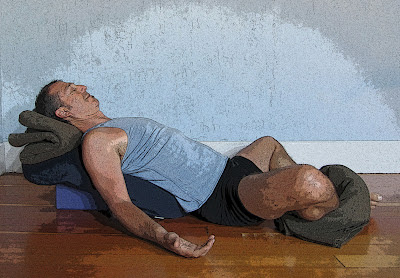by Nina
Last fall I did a series of posts on yoga and stress. Working from my first major post on the topic (see Relaxation Response and Yoga), which listed the various types of poses and practices that are helpful for stress, I added posts that expanded on each of the items I listed, except one: restorative yoga. My reason for skipping over the topic of restorative yoga was simple: I didn’t have any good photographs of restorative yoga poses that I could use with my post! But last week for Baxter’s post on digestion (see Mini Restorative Practice for Digestion), I finally had a chance to take a few photos of three of the classic, most frequently practiced restorative poses. And I woke up this morning realizing that it was finally time to address this topic.
Restorative yoga is a form of yoga that was specially designed to provide deep rest and relaxation. In restorative yoga, you use props to support yourself in the shape of a classic yoga pose, including forward bends, backbends, side stretches, twists, and inversions. For example, in Child’s Pose, rather than folding forward all the way on to the floor, you use a bolster or stack of folded blankets to support your entire front body.

The props you use in restorative yoga not only make the pose more comfortable but they take the effort out of the pose. Rather than using your muscles to hold you in the shape of a pose as you would normally, the props hold you in the pose so you can simply let your muscles relax. With your muscles completely relaxed, you can then turn your attention inward, focusing on your breath, physical sensations, or any other object of meditation, which allows the relaxation response to switch on.
Restorative yoga is perfect for those days when you depleted, sick, stressed out, low on energy or are just in the mood for a soothing practice. For people who can’t practice inversions for stress reduction, restorative yoga poses are an excellent alternative. For example, Reclined Cobbler’s pose with props is the perfect choice for a 10 to 20 minute stress reduction practice.

Are you looking at this photograph and wondering why you would want to go through all the trouble of getting all those props together when you can just lie down in Savasana (Corpse pose)? Well, I’m writing today to answer that very question.
First of all, like active yoga poses, the type of restorative pose you do can have a strong effect on your moods and emotions. And because you typically stay in a restorative yoga pose for longer periods of time, the emotional effect can be even stronger. For example, the forward bend of Child’s pose is normally quieting (as a forward bends for people who can practice them comfortably), and the restorative version is even more quieting. Active backbends can be simulating and uplifting, and while the restorative versions are not stimulating (all the effort is taken out of them), a restorative backbend can also be uplifting, providing an anti-depressant effect. (See Yoga and Your Emotions for information on the emotional effects of poses.)
And, secondly, in Savasana your body is in an anatomically neutral position, so no muscles are being released or stretched. In a restorative pose, however, you still receive many of the benefits of the pose itself. For example, in a restorative backbend, you are opening your chest and stretching many of the muscles that become tight after driving long distances or sitting hunched forward at a desk all day. Passively stretching your muscles as your relax increases your feeling of relaxation, as some of the stress you have been holding in your body is gently released. And because you are completely comfortable and relaxed, you can stay in the pose for much longer amounts of time. So restorative poses are actually a good way to work on flexibility, as well as relaxation.
But the best way for you to understand the benefits of restorative yoga is to experience them. So if you’ve never tried restorative yoga, experiment by trying either one of the poses I’ve shown today (or any other you’ve seen before). As always, you can just do a single pose or you can do short or full-length sequence (see Mini Restorative Practice for a short sequence). If you’re feeling hyper from stress or anxiety, you may find it difficult to lie down in a restorative pose. In this case, I recommend doing either an active yoga practice or some other form of exercise first before the restorative pose.
Follow Yoga for Healthy Aging on Facebook ° To order Yoga for Healthy Aging: A Guide to Lifelong Well-Being, go to Amazon, Shambhala, Indie Bound or your local bookstore.


Great explanation of the benefits of restorative yoga poses. I also like "legs up the wall" with a bolster under my back and a pillow for my head, eye mask, etc. :)